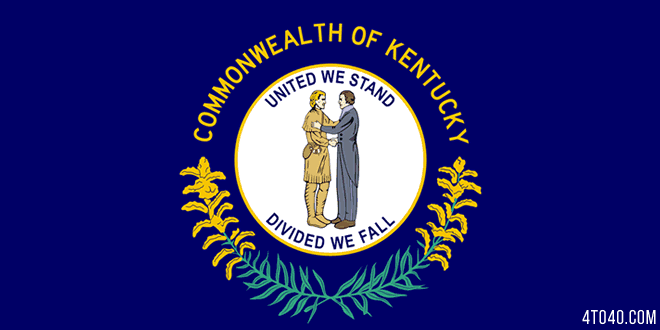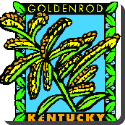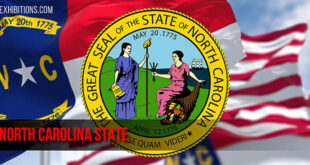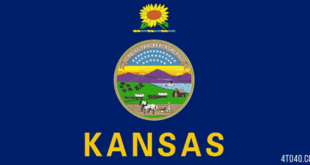Kentucky — Kentucky presents a mixture of both the Midwest and the South. The northern, more urban portion of the state, particularly the Ohio Valley corridor, is characterized by manufacturing and is oriented to the Midwest. Southern and western Kentucky tends to be rural in nature, concentrating on agriculture and mining; they are generally associated with the South. The state’s abundant natural resources, scenic beauty, historic treasures, and proud people contrast with Kentucky’s problems of poverty, poor housing, and low levels of education.
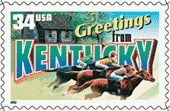
Kentucky is centrally located within the eastern United States, bordered by the seven states of Illinois, Indiana, Ohio, West Virginia, Virginia, Tennessee and Missouri. The state has an extreme width of 290 km (180 mi) and a length of 676 km (420 mi). Kentucky was once an Indian hunting ground. The name is believed to come from an Indian word meaning “prairie.” White men had explored the area by 1750. In 1792, Kentucky separated from Virginia to become the 15th state.
cKentucky State: Land & Resources
Kentucky shows diversity in its terrain. Considerable areas of plains, many hills, and a limited mountainous area in southeastern Kentucky, the highest part of the state, can be found in the state. Elevations generally decrease to the west and north, varying from 610 to 914 m (2,000 to 3,000 ft) in the southeast to between 122 and 183 m (400 and 600 ft) in the northwest and 396 m (1,300 ft) in the north. The highest point is Black Mountain, 1,262 m (4,139 ft), located near the Virginia border; the lowest elevation, 78 m (257 ft), is the Mississippi River along the state’s western tip.
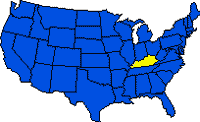
The state may be divided into six regions that closely conform to geologic structure. The Pennyroyal region, located in central and western Kentucky and named for a type of mint native to the area, is a flat-to-rolling limestone agricultural area. It extends nearly two-thirds of the distance across the state and accounts for about 30% of the total area.
Well to the east of the Pennyroyal, the Eastern Mountain and Coalfield claims more than 25% of the land. This part of the state, Kentucky’s Appalachia, is characterized by vast coal resources, rugged terrain, and widespread poverty. The Knobs, a narrow crescent-shaped belt of conical hills, contains less than 10% of Kentucky’s area and surrounds the limestone-based Bluegrass region, centered on Lexington. The Bluegrass region covers about one-fifth of the state along the Ohio River. It is famous for its horse farms, tobacco, and cattle.
The Western Coalfield, more than 10% of the state, is a relatively rolling sandstone and shale area north of the Pennyroyal where agriculture and area stripping of coal takes place. To its west, the Jackson Purchase, 6% of Kentucky, is that region lying west of the Tennessee River which was bought from the Chickasaw Indians in 1818 by Andrew Jackson and former governor Isaac Shelby. It is characterized by large farms developed on unconsolidated floodplain deposits.
The state is geologically simple: rocks are sedimentary and consist primarily of limestones, sandstones, and shales. The strata are nearly horizontal except for deformation associated with thrust faulting in mountainous southeastern Kentucky. Rocks vary in age from the recent (less than 10,000 years) in the Jackson Purchase to more than 420 million years, found in the Ordovician limestones of the Bluegrass.
Soils are primarily woodland residual, but extensive areas possess alluvial and aeolian, or wind-borne, soils. The most fertile soils are associated with alluvial deposits along the Mississippi and Ohio rivers and their tributaries.
Climate
The climate is moderate but variable. Kentucky’s weather is influenced by warm air from the Gulf of Mexico in summer and by cyclonic storms during winter. The state’s location in the path of major storm tracks contributes to frequent weather changes.
The west is slightly warmer than the east in summer, and the south is marginally warmer than the north in winter. Summer temperatures range from highs of 33 deg C (92 deg F) to lows of 17 deg C (62 deg F). Winter highs average 10 deg C (50 deg F) and lows minus 3 deg C (26 deg F). The growing season extends from 206 days in the west to 165 days in the southeast.
Annual precipitation decreases from south to north, with northern Kentucky receiving an average of 1,016 mm (40 in) and southern Kentucky more than 1,270 mm (50 in). Much of the state’s rainfall occurs between March and June; the least amount occurs in October. Severe storms can occur any time of the year but are most common from March to September.
Historical Sites
Federal, state, and local historic attractions total nearly 2,000 in number. Some of the more significant include reconstructed forts Harrod and Boonesborough; Cumberland Gap; the Abraham Lincoln and Jefferson Davis birthplaces; Ashland, home of Henry Clay; Federal Hill, known as Stephen Foster’s “My Old Kentucky Home”; and the communities of Danville and Frankfort, the state capital.
Tourism
Five federal parks lie wholly or partly within the state: Mammoth Cave National Park, Cumberland Gap National Historical Park, Abraham Lincoln Birthplace National Historic Site, the Big South Fork National River and Recreation Area, and Land Between the Lakes National Recreation Area (a Tennessee Valley Authority recreation site). The Kentucky state park system supervises 17 areas, the newest of which is Kentucky Horse Park, near Lexington. Breaks Interstate Park is jointly operated by Kentucky and Virginia.
Six areas are significant to tourism: the Kentucky and Barkley lakes area, the Mammoth Cave area, scattered locations in and near Daniel Boone National Forest, the Lake Cumberland area, Lexington and the Bluegrass area, and Louisville. The state has four Thoroughbred and three standardbred, or harness, race tracks. The best known include the Thoroughbred tracks at Churchill Downs in Louisville, site of the KENTUCKY DERBY, and Keeneland Race Course in Lexington, one of the country’s most beautiful racing facilities. Also popular is the historic Red Mile in Lexington, site of many record-setting harness races. Rupp Arena, one of the nation’s largest college basketball facilities, is in Lexington.
Kentucky State: History
Indians established civilizations in Kentucky more than 13,000 years ago. When the first white people entered the area, it was being used as a hunting ground by the SHAWNEE and CHEROKEE Indians.
One of the early explorers, Dr. Thomas Walker, entered Kentucky after discovering Cumberland Gap in 1750. The gap provided a relatively easy route through the Cumberland Mountains, and in subsequent years countless explorers and settlers were to move through it. One of the best-known explorers was the legendary Daniel BOONE, who first arrived in 1767. Others reached Kentucky via the Ohio River and established settlements at Maysville and Louisville.
The first settlement of Fort Harrod, now known as Harrodsburg, was established by James Harrod in 1774.
Boonesborough was settled in 1775 by Daniel Boone and his companions. Increased settlement brought pressures for statehood. Following conventions in Danville, the first constitution was approved in April 1792; Kentucky became the 15th state on June 1, 1792. In what was essentially a compromise between Lexington and Louisville, Frankfort was selected the state capital. The new state legislature adopted a strong STATE RIGHTS position when it adopted (1798) resolutions opposing the Alien and Sedition Acts (see KENTUCKY AND VIRGINIA RESOLUTIONS).
Between statehood and the Civil War, Kentucky increased its population from about 75,000 to more than 1 million. Slavery became the dominant social and political issue as the state expanded its farm production. An agricultural market downstream on the Mississippi River was assured by the Louisiana Purchase in 1803. The steamboat provided transportation on the Ohio River by 1815, and a rail system was developed before 1860.
A border state, Kentucky attempted to remain neutral during the Civil War but was unsuccessful because of its strategic location and the divided loyalties of its citizens. Farmers who used the Ohio and Mississippi rivers for transporting their produce wanted access to both waterways and the international port of New Orleans. If the South separated itself from the North, this free access would be impeded. On the other hand, influential plantation owners and state rights advocates sided with the Confederacy. As a result, Kentuckians could be found in both Union and Confederate armies. Confederate forces invaded Kentucky in 1861. Most of the fighting within the state’s boundaries, however, had ceased by 1863, after the Confederate army was driven out.
After the Civil War, the state changed economically and socially. Tobacco replaced hemp as the major agricultural crop. Coal mining was stimulated by the extension of rail lines into the coalfields of the eastern part of the state. Increased employment opportunities arose in manufacturing and services, and the major cities grew rapidly. After 1920 the state began a 70-year trend of decreases in rural population and growth in urban areas.
From World War II to the present day, Kentucky has changed with the nation. Certain internal events, however, have had a particular impact on Kentucky’s historic development. A modern highway system of interstate routes and an extensive parkway toll-road system connecting all parts of the state have been established. Authorization for the 15 Area Development Districts, beginning in 1968, showed serious efforts to plan for the state’s future. Aggressive state involvement with industrial development and stimulation of tourism was begun, particularly with the promotion of the state park system. The state joined in the formation of the Appalachian Regional Commission in 1965 and obtained assistance from the Tennessee Valley Authority in the western part of the state. Higher education was upgraded through the creation of regional universities and community colleges, along with the Kentucky Educational Television Network. A coal severance tax was enacted, to be levied at the time of extraction on an industry whose technological changes have resulted in an increased use of machinery rather than human labor, a major shift from underground mining to surface mining, and an increase in pollution. The state’s judicial system was revamped in 1976. Increased concerns for educational quality and funding contributed to the establishment of a statewide lottery in 1989 and to the Education Reform Act of 1990. Significant changes have since occurred in school funding, organization, and in taxation.
In order to realize its potential, Kentucky must solve a number of problems: regional economic inequality; a low standing in education; poor transportation in certain areas; widespread pollution problems, particularly with regard to the mining industry; and an agricultural base overly dependent on tobacco.
Kentucky’s future looks promising, however. Continued economic development is possible because of a current emphasis on education reform and the state’s advantages in energy, natural resources, transportation, water, scenery, and climate. With intelligent land-use planning, the state’s abundant resources, coupled with a relatively low population density, should provide Kentuckians with an improved economy and a better overall quality of life.
Kentucky State: Land
- Area: 104,665 sq km (40,411 sq mi); rank: 37th.
- Capital: Frankfort (1990 pop., 25,968).
- Largest city: Louisville (1990 census, 269,063).
- Counties: 120.
- Elevations: highest–1,262 m (4,139 ft), at Black Mountain; lowest–78 m (257 ft), at Mississippi River.
 Kids Portal For Parents India Kids Network
Kids Portal For Parents India Kids Network
